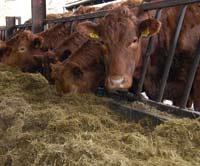Crimped barley is cheaper feed solution

A small-scale trial on a Welsh hill farm has indicated potential for cutting the cost of overwintering growing beef cattle.
Consultant nutritionist David Peers persuaded the Williams family to substitute home-grown crimped barley for part of the 16% protein blend fed to Stabiliser-weaned calves at Cappele farm, Cerrigydrudion, Clwyd.
Alwyn Williams, who farms 240ha (593 acres) in partnership with his wife Lowri, son Sion and daughter in law Ceinwen, runs 80 Stabilser sucklers, producing breeding stock for sale and steers for finishing through the Givendale Prime branding initiative in Yorkshire.
The May-born steers are sold by weight at 10 to 12 months old, so the aim is to achieve reasonable weight gains from weaning at Christmas to sale weighing about 400kg.
The policy has been to feed grass silage plus 3.2kg a head a day of a 16% cereal-based blend costing about £200/t. While the partners believe the system makes economic sense, they accept that the sums will look different when organic conversion, started in January 2008, is complete.
“It is a two-phase conversion and at present they are converting the land,” Dr Peers told farmers attending an Organic Centre Wales/Farming Connect-organised farm walk on the unit.
“Converting the livestock will mean paying at least twice as much for a comparable organic feed. The small trial we have run looked at the impact of reducing the amount of protein fed.”
Between 16 January 16 and 25 February one group of steers weighing an average of 317kg a head were fed ad-lib 32%DM silage, plus 3.2kg of the normal blend a day. The rest received the same quality silage supplemented by 2kg of blend and 1.4kg of crimped spring barley a head a day.
Dr Peers said the total quantity of feed was increased by 0.2kg a head a day for the crimped barley group to compensate for the lower dry matter of treated cereal.
“The level of protein fed was diluted from 16-14%, but the steers on blend plus barley gained 1.14kg a day compared with 1.11kg for those on blend.
“The results meant cattle on both feeding regimes gained an average of 1.2kg a head a day from birth to the end of February.”
Dr Peers estimated the cost of the crimped barley was £80/t compared with £200/t for the blend and £450/t for a 16% organic blend.
While it would be more expensive to grow an equivalent tonnage of organic barley, the trial suggested there would be considerable scope for cutting winter feed bills without sacrificing cattle performance.
Heather McCalman of the Institute of Biological, Environmental and Rural Sciences, said growing barley for crimping was just one part of family’s strategic plan for containing organic feed costs.
“The advice is to grow as much energy and protein as possible at home. There is no perfect blueprint. You have to sit down and draw up a farm-specific strategic plan.”
This could just mean optimising grass and clover production and use or introducing an arable rotation, possibly exploiting the grants available through environmental scheme cropping options.
At Cappele, where land runs from 1000-1600ft, the partners had pinpointed which fields could be ploughed and were combine-harvester accessible.
“We found that 315 acres are ploughable, but only 240 were suitable for combinable crops.” Subject to the results of soil testing, she suggested a 12-year rotation in which a three-year red clover ley would be followed by two cereal grain crops, a five-year white clover ley and two years of cereals.
The first priority had to be to get the most from nitrogen fixing grass clover leys, through both grazing and conservation, and then introduce arable cropping that suited the far. But she warned that the cost of growing potentially lower organic crop yields must be a consideration.
Alwyn Williams said he had grown Swedes for many years to feed the 750 Talybont-type Welsh Mountain in-lamb ewes. Taking up arable options would be helped by the fact that his son also ran a contracting business.
The availability of machinery, including a trailing shoe slurry applicator, manure spreader, forage wagon and cultivation equipment, had motivated the switch to organic production.
